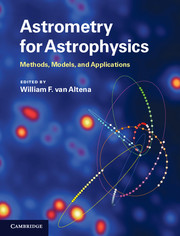Book contents
- Frontmatter
- Contents
- List of contributors
- List of acronyms
- Preface
- Part I Astrometry in the twenty-first century
- 1 Opportunities and challenges for astrometry in the twenty-first century
- 2 Astrometric satellites
- 3 Ground-based opportunities for astrometry
- Part II Foundations of astrometry and celestial mechanics
- Part III Observing through the atmosphere
- Part IV From detected photons to the celestial sphere
- Part V Applications of astrometry to topics in astrophysics
- Index
- References
1 - Opportunities and challenges for astrometry in the twenty-first century
from Part I - Astrometry in the twenty-first century
Published online by Cambridge University Press: 05 December 2012
- Frontmatter
- Contents
- List of contributors
- List of acronyms
- Preface
- Part I Astrometry in the twenty-first century
- 1 Opportunities and challenges for astrometry in the twenty-first century
- 2 Astrometric satellites
- 3 Ground-based opportunities for astrometry
- Part II Foundations of astrometry and celestial mechanics
- Part III Observing through the atmosphere
- Part IV From detected photons to the celestial sphere
- Part V Applications of astrometry to topics in astrophysics
- Index
- References
Summary
Introduction
The fundamental task of measuring stellar positions, and the derived properties of trigonometric distances and space motions, has preoccupied astronomers for centuries. As one of the oldest branches of astronomy, astrometry is concerned with measurement of the positions and motions of planets and other bodies within the Solar System, of stars within our Galaxy and, at least in principle, of galaxies and clusters of galaxies within the Universe as a whole.
While substantial advances have been made in many areas of astrometry over the past decades, the advent of astrometric measurements from space, pioneered by the European Space Agency's Hipparcos mission (operated between 1989 and 1993), has particularly revolutionized and reinvigorated the field. Considerable further progress in space and ground measurements over the next decade or so collectively promise enormous scientific advances from this fundamental technique.
At the very basic level, accurate star positions provide a celestial reference frame for representing moving objects, and for relating phenomena at different wavelengths. Determining the changing displacement of star positions with time then gives access to their motions through space. Additionally, determining their apparent annual motion as the Earth moves in its orbit around the Sun gives access to their distances through measurement of parallax. All of these quantities, and others, are accessed from high-accuracy measurements of the relative angular separation of stars. Repeated measurements over a long period of time essentially provide a stereoscopic map of the stars and their kinematic motions.
- Type
- Chapter
- Information
- Astrometry for AstrophysicsMethods, Models, and Applications, pp. 3 - 13Publisher: Cambridge University PressPrint publication year: 2012

